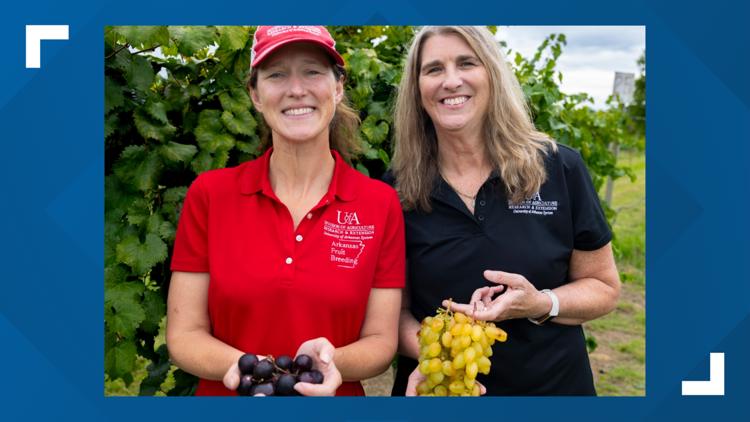FAYETTEVILLE, Ark. — With support from a $7 million grant that was received from the U.S. Department of Agriculture's National Institute of Food and Agriculture, a team comprised of 32 people from across the nation has been working to combine two different types of grapes.
They have been working to combine muscadine grapes with Vitis vinifera (bunch grapes), in hopes of improving the fruit crop.
This project of combining the grape types, known as VxM (Vitis x Muscadinia), is co-directed by Renee Threlfall and Margaret Worthington with the Arkansas Agricultural Experiment Station, which is the research arm of the University of Arkansas System Division of Agriculture.
“This project has been a decade in the works, waiting for the right project partners to form this team,” said Threlfall, associate professor of enology and viticulture in the food science department. “A lot of planning and collaboration made this opportunity a success. Our goal is the introduction of disease-resistant cultivars with enhanced fruit quality leading to a more resilient U.S. grape industry.”
Threlfall explained how breeding efforts between both grape types to create wide hybrids have already begun in parts of the U.S. and in some parts of Europe. This has resulted in new grape varieties, some of which have attributes of one type or the other, and many which have attributes from both.
“It’s like crossing a horse and a donkey… you get a mule that is highly sterile,” Worthington said. “When you cross muscadines with bunch grapes you get more grapes and can back breed with the goal of having a disease-resistant bunch grape or a muscadine with improved traits.”
The grape breeding project has six objective-based teams that are focused on different things such as breeding, genetics, pathology, quality, marketing, and production.
Threlfall is the person leading the team that is focused on quality, meanwhile, Worthington leads the breeding team. The end goal of the project is to develop new grape hybrids by combining some of the best attributes from both the Vitis vinifera and the muscadine grapes.
“Breeding hybrids is a common practice in crop improvement, but not always easy due to the difficulty in producing fertile progenies,” said Qi Sun, research scientist and co-director of the bioinformatics facility at Cornell University.
“This project gives us a unique opportunity to systematically study the genetics of the muscadine and European grape hybrids, to have a better understanding of the biological barriers for crossing between these two different grapes and how to overcome them," he added.
Research shows that Vitis vinifera (bunch grapes) can be susceptible to many diseases which the muscadine grapes are naturally immune to.
“In fact, the two most widely used resistance genes in breeding new bunch grape cultivars come from muscadines, from a cross-hybridization made in 1917," said Lance Cadle-Davidson, research plant pathologist for the USDA-ARS, who leads the VxM pathology team.
The overall goal of the project is to provide bunch grape and muscadine breeders with 10 disease-resistance genes in a four-year time span. This is being done in hopes of targeting powdery mildew, downy mildew, black rot, and grapevine leafroll-associated virus 3.





